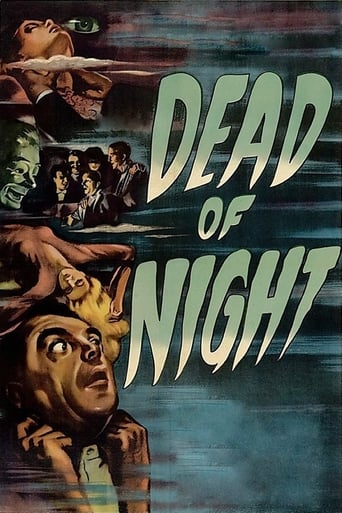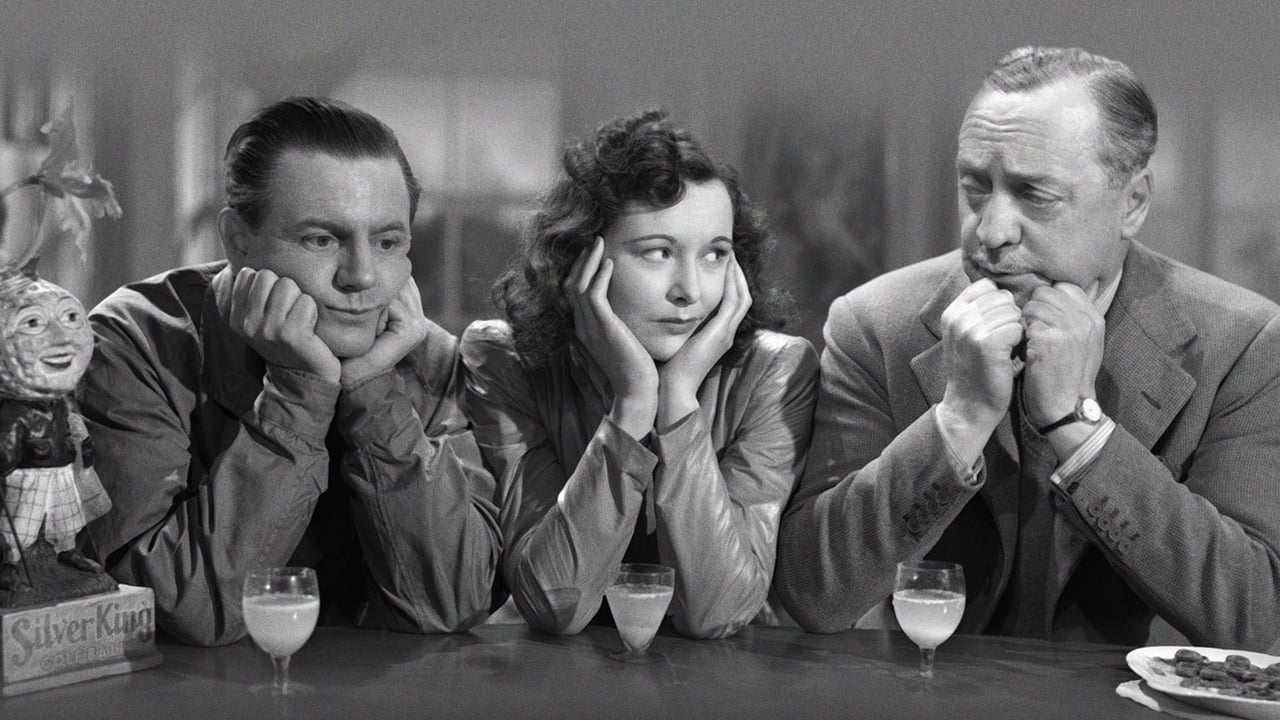BA_Harrison
An early entry in the horror anthology sub-genre, Dead of Night is an important and highly influential offering from Ealing Studios, one that has provided inspiration for numerous later scary movies, including the popular Amicus portmanteau films of the '60s and '70s.But as noteworthy as it undoubtedly is, Dead of Night is also somewhat over-rated, the film suffering from that frequent horror anthology handicap, the comic relief story, and just a little too much of the wraparound tale, which begins as architect Walter Craig (Mervyn Johns) arrives at the country home of Eliot Foley (Roland Culver) and his wife (Mary Merrall), having been invited to stay the weekend.As Walter is introduced to the other guests in the house, he experiences a sense of déjà vu, recognising the names and faces from a recurring nightmare, which he proceeds to divulge. This, in turn, leads to each person recounting their own experience of the supernatural.Tale number one, The Hearse Driver, is short but sweet, telling of how race car driver Hugh Grainger, injured in a crash, is saved from certain death by a haunting vision of a creepy hearse driver. The shock ending is memorable enough that one can easily forgive the unconvincing miniature model effect.Story two is traditional ghost story Christmas Party, with Sally O'Hara (Sally Ann Howes) befriending a small boy, unaware that he is in fact the spirit of a murdered child. The twist in the tale is not at all surprising, a disappointment considering the wonderfully melancholy atmosphere that had been so carefully established.The third tale to be recounted, The Haunted Mirror, is one of the best, and sees Peter Cortland (Ralph Michael) slowly becoming possessed by the spirit of a murderer after his wife (Googie Withers) buys him a haunted mirror. Extremely creepy and well played by Michael and Withers, this one would provide the inspiration for a chapter in the excellent From Beyond The Grave (1974).Golfing Story stars Basil Radford and Naunton Wayne as sporting and love rivals George and Larry, who play a round of golf to decide who shall win the hand of the woman they both adore. Loser Larry kills himself and winds up haunting George, who had cheated during the game. Played for laughs, this one is out of place and could have been left on the cutting room floor (the shorter American version of the film did just that, along with Christmas Party).The last segment is about a ventriloquist (Michael Redgrave) who believes that his doll is alive. If that sounds familiar, it's could be because the same idea was used for the Anthony Hopkins film Magic (1978). Like Magic, this one is supremely creepy—there's something that is inherently unsettling about a ventriloquist doll, and this one wastes no opportunity to freak out the viewer.With its five tales told, Dead of Night wraps things up by revealing that everything we have seen thus far has been part of Walter Craig's recurring dream. The architect wakes up and receives a phone call: it's Eliot Foley inviting him to stay for the weekend. The cyclical dream ending might seem trite these days, but was probably considered rather clever back in 1945.With more killer than filler, the film is still a neat package of spooky stories, one that will no doubt please most fans of the multi-story format. If anything, it's worth seeing just to see quite how many of the characters light up a cigarette during the entire film: it's almost like smoking was mandatory in the '40s.
Nigel P
Ealing films, the warm and cosy home of lovingly crafted British comedies, branched out into slightly more unnerving territory with this early anthology. At a country house, in an age where, following communal afternoon tea, the local doctor likes to offer round the cigarettes, Walter Craig (Mervyn Johns) turns up and recognises the ensemble (none of whom he has ever met) from his recurring dreams.In this world, where everyone speaks in the clipped tones of racing horse commentators, ("I can't leave. This is Mr Craig and I'm a character in his dream." "Oh how do you do? Such fun, charades!") the anecdotal stories everyone tells merely confirm Craig's suspicions. He can see their future: he knows what is going to happen.I cannot knock a 72 year old production for being dated, so I won't. But it is. The extreme politeness and styles are often difficult to get past, even harder to take seriously. To begin with, such chills as there are are very tame and wholesome. The segment featuring the malevolent mirror is where things pick up, giving the impression 'Dead of Night' is unveiling its frights in a measured way. Until the following dreadful golfing farce sequence lets things down. "Totally incredible and decidedly improper," to quote Mrs Foley (Mary Merrall).If you can sit through that segment, the best and most widely remembered is saved till last. Maxwell Frere (Michael Redgrave) is a ventriloquist, performing and popular with packed audiences every night. So when it becomes apparent that the dummy Hugo appears to be the controlling element of the partnership, initially amusing music-hall scenes become genuinely tense. This is partly due to the writing, in which Hugo's comedy jibes to his partner become increasingly spiteful, and Redgrave's performance, in which the showbiz charade slips and he becomes edgy whilst still continuing with the act.The Director for this final segment is Alberto Cavalcanti, who eschews the brightly lit jollity of the other stories and coaxes an intense performance from Redgrave. To say this finale is the best of the bunch is understating things. In its way, it is a masterpiece.In case Walter Craig's plight has been forgotten in all this, the twist ending gives the film's climactic moments a nice sense of closure.
Rainey Dawn
This film was recommended to me and I am glad I was able to find a copy to watch. This is a good film - hard to find on VHS, DVD or Blue-ray and rarely airs on TV (if at all).There are five stories within one. The story base is of a man that has reoccurring dreams the ending will tie this base story in with the other five stories - a neat way to end the film."The Hearse Driver" and "The Christmas Party" are two good fairly creepy stories that will wet your appetite for the next two segments. "The Haunted Mirror" and "The Ventriloquist's Dummy" are the best two stories of the five - these two are really good and scary. The last segment "Golfing Story" is cute... it will lighten up the mood of the viewer, bring you back to a more cheerful state before the end of the film which ties everything together.A good film - if you can find a copy to watch I would recommend you watching.8/10
utgard14
Classic supernatural anthology film starts when architect Walter Craig (Mervyn Johns) arrives at a country house along with several other guests. Craig has been having a recurring nightmare and it starts this same way. As each guest takes their turn telling their story, it becomes clear to Craig that his nightmare is coming true. This is the set-up for the film, where each guest's story is told.The first story, "The Hearse Driver," is about a racing driver (Anthony Baird) who is haunted by a vision of a hearse (coach not car). The second story, "The Christmas Story," is a ghost story about a group of kids playing hide & seek at a Christmas party, where a young girl (Sally Ann Howes) meets a mysterious boy in the attic. Both of these stories are good but fairly routine efforts. Anybody who has seen or read ghost stories, even in 1945, will have encountered similar material. "The Haunted Mirror" is the third story is about an antique mirror a woman (Googie Withers) buys that seems to have a strange hold on her husband (Ralph Michael). This is possibly my favorite story in the film. It's definitely the most underrated. Ralph Michael gives a fantastic performance as the man drawn to this strange mirror and being slowly driven to kill.The fourth story is a humorous one called "The Golfing Story," about a pair of friends (Basil Radford, Naunton Wayne) who are rivals for the same girl. They decide to settle who gets her over a game of golf. It's a likable, frivolous story, written by H.G. Wells, and sandwiched between two darker ones, presumably to lighten the mood somewhat. The last, and most famous, story from the film is "The Ventriloquist's Dummy." Psychologist Dr. van Straaten (Frederick Valk) tells how he was called in to determine the sanity of a ventriloquist (Michael Redgrave) who claims his dummy Hugo is alive. This story is the one for which the movie is most remembered. Obviously there have been dozens of similarly-themed stories down through the years. If you have seen some or most of those before you come to Dead of Night, you might be less impressed by this story. Still, it's very good with an outstanding performance by Redgrave.The beginning of the film ties back in at the end in a clever way that is one of the best twist endings to a horror anthology film I've seen (and they all seem to have them). What I said before about the impact of the final story being diluted somewhat by years of imitations, remakes, homages, etc. can be said for the entire film. Most of these stories have been done, in one variation after another, in films and television shows for decades. I think this is perhaps why the film is not more widely regarded today. I've recommended the film to several people over the years and they've all come away liking it but also with a sense of disappointment. To a person they all cite the sense of familiarity of some of the stories, particularly the ventriloquist one. Unfair as it is, that's just an unfortunate side effect of being an influential film. I would still recommend you watch it and try it for yourself.


 AD
AD






